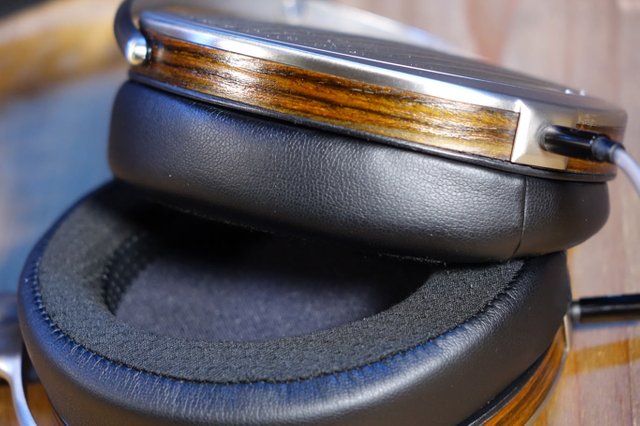HiFiMan Susvara - circumaural, magnetoplanares and open-space headphones
HiFiMan Susvara
circumaural, magnetoplanares and open-space headphones
Screenshots



Hunter's comment
The first thing we want to do is identify what kind of proposal we have in hand. The Susvara are circumaural, magnetoplanares and open-space headphones. As you can see in the photographs, the fastening system they use is a headband, which is the option that manufacturers usually opt for when they set up headphones for high-fidelity applications.
Its circumaural design ensures that our ears are completely encapsulated inside the enclosure of the headphones, which is also open. This last feature manages to eliminate the internal resonances inside the enclosure, but it has a double counterpart: it does not isolate us from outside noise, and, in addition, it allows the sound of the headphones to filter out, making it easier for other people to hear it.
Even so, the advantages of open circumaural designs are many, both because of their direct influence on sound and on ergonomics. The models of these correctly executed characteristics usually offer a detailed, dynamic sound, with a realistic timbre and a wide sound scene that can rival with that provided by good acoustic boxes. In addition, its circumaural architecture prevents the pads from directly pressing on our ear pavilion, making it possible to use them during prolonged listening sessions in a comfortable way.
Another interesting detail of these headphones in which it is worthwhile to notice is that, due to the design of their transducers, they are magnetoplanar type. A transducer is nothing more than an element designed to transform one type of energy into another, so in a pair of headphones this component transforms electrical energy, which receives from the amplifier and that contains the musical information, into acoustic energy, which manifests itself as the variations of pressure that we perceive in the air and that our brain interprets as sound.
In headphones, regardless of their type, the transducer is made up of two fundamental elements: the diaphragm and the magnet. Of course, there are other components, but in this analysis we are interested in specifically delving into these two. The diaphragm of the magnetoplanares designs is a flat, light and extremely thin layer of a rigid material whose vibration causes the pressure changes in the air, which, as I anticipated in the previous paragraph, are perceived by our auditory system and interpreted by our brain as sound.
The two most sophisticated components of these headphones are the diaphragm and the magnetic motor to which they turn
The element responsible for causing this mechanical vibration of the diaphragm is the magnet, which is designed to respond to the fluctuations of the electrical current coming from the amplifier, which are what ultimately cause the movement of the diaphragm thanks to traces housed on its surface and through which electricity circulates. Of the precision with which the interaction between the magnet and the traces of the diaphragm responds to any variation of the electrical signal, however subtle it may be, depends on the resolution that the headphones will offer, which is nothing more than the ability to reproduce any musical detail, however imperceptible it may seem.
A well-designed magnet should not only be capable of generating a magnetic field of high intensity, when necessary, and therefore able to accurately control the movement of the diaphragm; that magnetic field also has to be symmetrical and evenly distributed over the entire surface of the diaphragm. As you can see, the importance of these two elements is maximum because they have a lot of weight in the quality of the sound that the headphones are going to offer us.
In my opinion, and after having spent several days of exhaustive analysis and listening sessions that have lasted for many hours with selected cuts, the HiFiMan Susvara respond to the philosophy I have just described. They bring together several innovations, especially as regards the diaphragm and the magnet, which may have required a significant effort in terms of R & D & I.
In addition, they are impeccably machined and assembled, reflecting meticulous manufacturing carried out with quality materials. And, finally, it is very likely that, beyond the real manufacturing cost of the Susvara, the people of HiFiMan have always kept in mind the price of the competitors with whom they want to measure, such as top brand models. like the Japanese STAX and Audio-Technica, the European Sennheiser and AKG, or the American Audeze and Grado Labs, among many others.
Link
https://store.hifiman.com/index.php/susvara.html
Contributors
Hunter: @stefidifelice

This is posted on Steemhunt - A place where you can dig products and earn STEEM.
View on Steemhunt.com
Hi @stefidifelice,
Thanks for your hunt. Before I can approve it, can you please change the product link (through the steemhunt website) to link to the specific model rather than to the HiFiMan homepage.
Please let me know via a comment reply when you’ve made requested changes. Thanks in advance!
ready friend, the link was changed
thanks for the help and I made the necessary changes
??????
already make the suggested changes
Resteemed your article. This article was resteemed because you are part of the New Steemians project. You can learn more about it here: https://steemit.com/introduceyourself/@gaman/new-steemians-project-launch